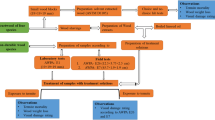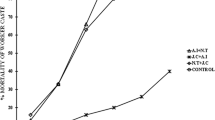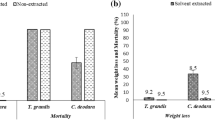Abstract
Termites are a major cause of damage to wood, and the use of synthetic insecticides for their control constitutes a significant challenge to environmental health. This study assessed the damage to the wood of four Eucalyptus species upon exposure to subterranean termites, as well as the efficacy of three plant oils and a synthetic wood preservative. The physical properties responsible for wood resistance were determined using standard procedures. Pearson correlation, Analysis of Variance (ANOVA), and Tukey’s Honestly Significant Difference (p < 0.05) were used for data analysis. The results showed that the greatest and least wood damage was recorded in Eucalyptus tereticornis and Eucalyptus cloeziana, respectively. The wood hardness recorded in E. cloeziana was higher than in E. tereticornis and correlated significantly with the percentage of wood loss. Solignum, a synthetic wood preservative, reduced the wood loss due to termite infestation more effectively than the plant oils. Oil extracts from neem seeds, Jatropha seeds, and palm kernels significantly reduced wood loss compared to the control treatment. However, the potency of the plant oils decreased over time. The wood of E. cloeziana demonstrated a high level of resistance against termite infestation, and neem oil, Jatropha oil, and palm kernel oils possess the potentials as alternatives to synthetic wood preservatives for wood protection.
Similar content being viewed by others
References
Abubakar IJ, Mahdi M (2015) Development of a plant for extraction of essential oil from leaves of Eucalyptus tree. International Conference on African Development Issues (CU-ICADI): Materials Technology Track pp. 164–169
Adeniyi BA, Ayepola OO (2008) The phytochemical screening and antimicrobial activity of leaf extracts of Eucalyptus camaldulensis and Eucalyptus torelliana (Myrtaceae). Res J Med Plant 2:34–38
Adeniyi BA, Odufowoke RO, Olaleye SB (2006) Antibacterial and gastroprotective properties of Eucalyptus torelliana (Myrtaceae) crude extracts. Int J Pharmacol 2(3):362–365
Ahmad N, Sarwar M, Khan GZ, Tofique M, Salam A (2011) Efficacy of some plant products and synthetic chemicals to manage the outbreak of mealybug (Maconellicoccus hirsutus) in cotton. J Agric Biol Sci 3(1):16–21
Ahmed S, Fatima R, Hassan B (2020) Evaluation of different plant-derived oils as wood preservatives against subterranean termite Odontotermes obesus. Maderas Cienc Tecnol 22(1):109–120. https://doi.org/10.4067/S0718-221X2020005000110
Alamu OT, Ewete FK, Alabi OY (2018) Laboratory evaluation of the termiticidal efficacy of three tropical plant oils on Macrotermes bellicosus (Blattodea: Termitidae). Acad J Entomo 11(1):11–17
Alamu OT, Suleiman RA, Ayandokun AE, Ete JA, George-Onaho JA, Agboola IS (2022) Pest status of termites on different Eucalyptus species in Afaka, Nigeria. J Appl Sci Environ Manag 26(1):71–74
Arango RA, Green F, Hintz K, Lebow PK, Miller RB (2006) Natural durability of tropical and native woods against termite damage by Reticulitermes flavipes (Kollar). Int Biodeterior Biodegradation 57:146–150. https://doi.org/10.1016/j.ibiod.2006.01.00
ASTM (1981) E 18–79, standard test methods for Rockwell hardness and Rockwell superficial hardness of metallic materials. ASTM International
ASTM International. ASTM D 1758-06 (2006) Standard Test Method of Evaluating Wood Preservatives by Field Test with Stakes. ASTM International; West Conshohocken, PA, USA: 2006
ASTM-D2395 (2017) Standard test methods for density and specific gravity (relative density) of Wood and Wood-Based materials. ASTM International, West Conshohocken, PA
ASTM, American Society for Testing and Materials (1974) Standard D 1758-74: standard methods of evaluating Wood preservatives by field test with stake. ASTM International. Philadelphia pp 490 – 498
ASTM. American Standard Test Methods (2003) Standard Test Method for Wood Preservatives by Laboratory soil-block cultures. D1413-99. ASTM International, West Conshohocken, PA
Behr EA (1972) Termite resistance of Northern White Cedar. Research report. Agricultural Experiment Station, Michigan State University. 11pp
Brune A (2014) Symbiotic digestion of lignocellulose in termite guts. Nat Rev Microbiol 14(12):168–180
Carter FL, Jones SC, Mauldin JK, Camargo CRD (1983) Responses of Coptototermes formosanus Shiraki to extracts from five brazilian hardwoods. Z für Angew Entomol 95:5–14
Chan W, Koehler PG, Tucker CL (2022) Subterranean Termites. Publication No. ENY-210. UF/IFAS Extension, University of Florida. Pp.7
Chen S, Weng Q, Li F, Li M, Zhou C, Gan S (2018) Genetic parameters for growth and wood chemical properties in Eucalyptus urophylla × E. tereticornis hybrids. Ann for Sci 75:16. https://doi.org/10.1007/s13595-018-0694-x
Delaplane KS, La Fage JP (1989) Preference of moist wood by the Formosan subterranean termite (Isoptera: Rhinotermitidae). J Econ Entomol 82:95–100
Dungani R, Bhat IUH, Abdul Khalil HPS, Naif A, Hermawan D (2012) Evaluation of antitermitic activity of different extracts obtained from indonesian teak wood (Tectona grandis L.f). BioResources 7(2):1452–1461
Ganapaty S, Thomas PS, Fotso S, Laatsch H (2004) Antitermitic quinones from Diospyros sylvatica. Phytochemistry 65:1265–1271
Georges BJ, Evariste F, Achille B, Joseph ZM, Moise NA, Dieudonné A, Lambert SM, Patrick AN (2022) Synergistic effect of Jatropha curcas seed oil and sodium tetraborate treatment on wood resistance to fungal attacks: case of Ayous (Triplochiton scleroxylon), a high value commercial wood species in tropical Africa. Wood Mater Sci Eng 17(3):186–191. https://doi.org/10.1080/17480272.2020.1836024
Gero M, Abe AS, Inuwa B, Babakura MA, Sule AM, Mohammed H (2012) Comparative evaluation of ethno-medicinal use of two species of Eucalyptus plant as an antimicrobial agent. Int J Sci Technol 2(8):2224–3577
Gupta BK, Sen Sarma PK (1978) Antitermite properties of some anthraquinone derivatives. Holzforschung und Holzverwertung 30:57–58
Haygreen JG, Bowyer JL (1982) Forest Products and wood science: an introduction. Lower State University Press, p 495
Hongoh Y, Ohkuma M, Kudo T (2003) Molecular analysis of bacterial microbiota in the gut of the termite Reticulitermes speratus (Isoptera; Rhinotermitidae). FEMS Microbiol Ecol 44:231–242
Ibrahim BU, Adebote DA (2012) Appraisal of the economic activities of termites. Bayero J Pure Appl Sc 5(1):84–89
Idoko OS, Gordon NC (2018) Anti-termitic properties of Jatropha (Jatropha curcas L.) on wood termites (Macrotermes bellicosus (Smeathman). 12th International Working Conference on Stored Product Protection (IWCSPP) in Berlin, Germany, October 7–11, 2018, 462–470
Idris UD, Aigbodion VS, Gadzama RM, Ahmed TY (2012) Suitability of maize cob particles and recycled low density polyethylene for particleboard manufacturing. Mat Sci 8(1):34–37
Istifanus AP, Abdelmutalab AGA, Pirk CWW, Yusuf AA (2023) Predicting the Habitat suitability and distribution of two species of Mound-Building Termites in Nigeria using Bioclimatic and Vegetation variables. Diversity 15(2):157. https://doi.org/10.3390/d15020157
Kemabonta KA, Balogun SA (2014) Species richness, diversity, and relative abundance of termites (Insecta: Isoptera) in the University of Lagos, Lagos, Nigeria. FUTA J Res Sc, (2): 188–197
Khan MA (2017) Termites and Sustainable Management, in W. A. Md. Aslam Khan (Eds.), Jazan, Saudi Arabia, Springer. https://doi.org/10.1007/978-3-319-72110-1
Lee CY, Chung KM (2003) Termites. In: Urban Pest Control: A Malaysian Perspective, Lee CY, Zairi J, Yap HH, Chong NL (Eds.). 2nd Edn Vector Control Research Unit, Universiti Sains Malaysia, Penang, Malaysia, ISBN-13: 9789832514398, pp: 99–111
Malaka SLO (1983) Economic importance of termites: six case studies in Nigeria and Ghana. Nigerian Field 47(4):222–230
Martín JA, López R (2023) Biological deterioration and natural durability of wood in Europe. Forests 14:283. https://doi.org/10.3390/f14020283
Medina C, Dobry R, Zeghal M, Thevanayagam S, Abdoun T, Elgamal A, Bennett V (2010) Biology of Termites: A Modern Synthesis. In N. Lo David Edward Bignell, Yves Roisin (Eds.), Engineering. Australian, Springer. https://doi.org/10.1007/978-90-481-3977-4
Nakabonge G, Matovu B (2021) Variation in susceptibility of Eucalyptus grandis and selected hybrid clones to two termite species Macrotermes bellicosus and M. Subhyalinus in Uganda All Life 14(1):120–126. https://doi.org/10.1080/26895293.2021.1883126
Nigerian Meteorological Agency, NiMet (2012) 2012 Nigeria Climate Review (59 pp.). Nigerian Meteorological Agency (NIMET), Abuja
Nyeko P, Nakabonge G (2008) Occurrence of pests and diseases in tree nurseries and plantations in Uganda. Study commissioned by the Sawlog Production Grant Scheme (SPGS), Pp.1–42
Okweche SI, Hilili PM, Ekoja EE (2021) Termiticidal activity of oil from Jatropha curcas L. and Azadirachta indica A. Juss against Coptotermes sjostedti Holmgren (Isoptera: Rhinotermitidae). Bull Natl Res Cent 45 9. https://doi.org/10.1186/s42269-020-00472-z
Oliveira JTS, Paes JB, Vidaurre GB (2017) Resistência biológica da madeira de espécies de eucalipto ao ataque de cupins de madeira seca. Sci For 45(113): 145–150. Available from: https://bit.ly/2X3SA16
Onifade KR (2001) Production of tannin from the bark of Eucalyptus camaldulensis. Assump Univ Thail J Technol (2): 66–72
Owoyemi JM, Olaniran OS (2014) Natural resistance of ten selected nigerian wood species to subterranean termites’ attack. Int J Biol Sci Appl 1(2):35–39
Owoyemi JM, Eniabiire OM, Emmanuel UO, Fuwape JA (2020) Efficacy of commonly used wood preservatives against subterranean termites in Akungba-Akoko, Ondo State, Nigeria. J Res for Wildl Env 12(1):111–121
Paes JB, Vital BR (2000) Resistência natural da madeira de cinco espécies de eucalipto a cupins subterrâneos, em testes de laboratório. (Natural resistance of wood from five eucalyptus species to subterranean termites, in laboratory tests)(In Portuguese). Rev Árvore 24(1):97–104
Papadopoulos AN (2010) Chemical modification of solid wood and raw materials for composites production with linear chain carboxylic acid anhydrides: a brief review. BioResources 5(1):499–506
Paul B, Khan A, Paul S, Shankarganesh K, Chakravorty S (2018) Termites and indian Agriculture. In: Khan M, Ahmad W (eds) Termites and sustainable management, sustainability in plant and crop protection. Springer International Publishing, pp 51–96
Peralta RCG, Menezes EB, Carvalho AG, Aguiar-Menezes EL (2004) Wood consumption rates of forest species by subterranean termites (Isoptera) under field conditions. Rev Árvore 28(2):283–289
Rockwood DL, Rudie AW, Ralph SA, Zhu JY, Winandy JE (2008) Energy product options for Eucalyptus species grown as short rotation woody crops. Int J Mol Sci 9:1361–1378
Santana ALBD, Maranhão CA, Santos JC, Cunha FM, Conceição GM, Bieber LW, Nascimento MS (2010) Antitermitic activity of extractives from three brazilian hardwoods against Nasutitermes corniger. Int Biodeterior Biodegradation 64:7–12
Sarwar M (2012) Competency of natural and synthetic chemicals in controlling gram pod borer, Helicoverpa armigera (hubner) on chickpea crop. Int J Agric Sci 2(4):132–135
Shanbhag RR, Sundararaj R (2013) Physical and chemical properties of some imported woods and their degradation by termites. J Insect Sci 13(63):1–8
Sim S, Lee SH (2012) Measurement of the time required for a termite to pass through tunnels with different curvatures. J Insect Sci 12(64):1–7
Sornnuwat Y, Vongkaluang C, Yoshimura T, Tsunoda K, Takahashi M (1995) Natural resistance of seven commercial timbers used in building construction in Thailand to subterranean termite, Coptotermes gestroi Wasmann. Japan J Environ Entomol Zool 7:146–150
Sotande OA, Yager GO, Zira BD, Abubakar U (2011) Termiticidal effect of neem extracts on the wood of Khaya senegalensis. Res J for 5:128–138. https://scialert.net/abstract/?doi=rjf.2011.128.138
Su NY, Tamashiro M (1986) Wood-consumption rate and survival of the Formosan subterranean termite (Isoptera: Rhinotermitidae) when fed one of six woods used commercially in Hawaii. Proc Hawaii Entomol Soc 26:109–113
Taylor AM, Gartner BL, Morrell JJ (2006) Effects of heartwood extractive fractions of Thuja plicata and Chamaecyparis nootkatensison wood degradation by termites or fungi. J Wood Sci 52:147–153
Waller DA (1989) Host selection in subterranean termites: factors affecting choice (Isoptera: Rhinotermitidae). Sociobiology 14:5–13
Ye C, Li J, Ran Y, Rasheed H, Xing L, Su X (2019) The nest fungus of the lower termite Reticulitermes labralis. Sci Rep 9:3384
Acknowledgements
The authors would like to thank Dr. S.E. Anamayi, the Head of Station, Trial Afforestation Research Station, Afaka, Kaduna, for access granted to work in all the available Eucalyptus plantations under the management of the station. We would also like to thank all the technologists at the Department of Metallurgical and Material Engineering, Ahmadu Bello University, Zaria, Nigeria, and the Department of Forest Resources Management, University of Ibadan, Ibadan, Nigeria; and forest overseers who contributed to the success of this study.
Funding
The authors did not receive support from any organization for the submitted work.
Author information
Authors and Affiliations
Contributions
OTA and FKE contributed to the conception, experimental work and interpretation of the analyzed data, writing and reviewing of the manuscript. The two authors read and approved the final manuscript.
Corresponding author
Ethics declarations
Competing interest
The authors have no competing interests to declare relevant to this article’s content.
Ethics approval and consent to participate
Not applicable.
Consent for publication
Not applicable.
Additional information
Publisher’s Note
Springer Nature remains neutral with regard to jurisdictional claims in published maps and institutional affiliations.
Rights and permissions
Springer Nature or its licensor (e.g. a society or other partner) holds exclusive rights to this article under a publishing agreement with the author(s) or other rightsholder(s); author self-archiving of the accepted manuscript version of this article is solely governed by the terms of such publishing agreement and applicable law.
About this article
Cite this article
Alamu, O.T., Ewete, F.K. Termites infestation on different Eucalyptus wood species and control using natural oil from plants. Eur. J. Wood Prod. 81, 1535–1542 (2023). https://doi.org/10.1007/s00107-023-01987-8
Received:
Accepted:
Published:
Issue Date:
DOI: https://doi.org/10.1007/s00107-023-01987-8




